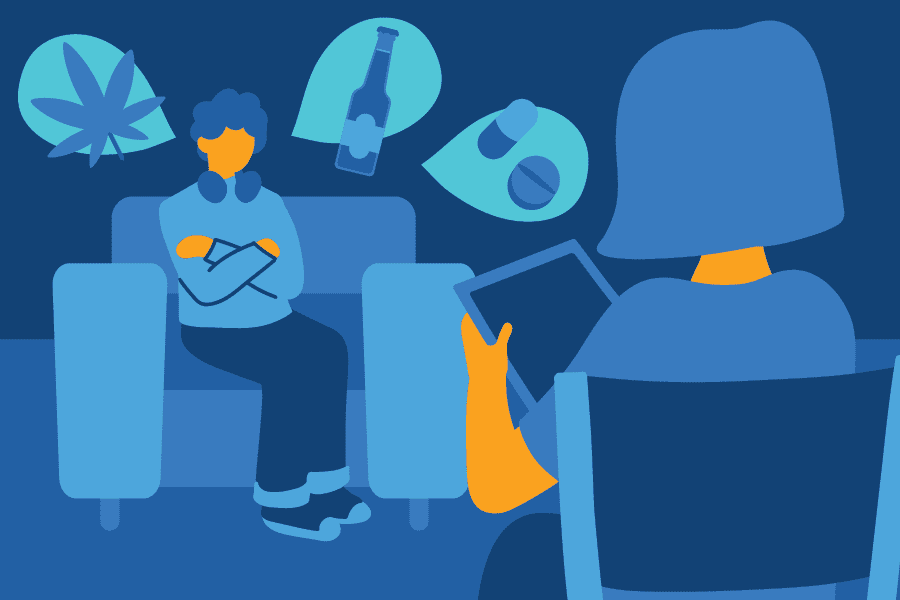How Cognitive Behavioral Treatment Works to Treat Teenage Substance Abuse


Even before the COVID-19 pandemic took a significant toll on teens’ mental health, the U.S. was experiencing a rising trend of mental distress among teenagers in the preceding decade.
Poor mental health, even without a diagnosed disorder, can lead to experimentation with alcohol and drugs and riskier behaviors, according to the Substance Abuse and Mental Health Services Administration, a federal government agency. Sandstone Care analyzed scholarly research and resources from the Centers for Disease Control and SAMHSA to examine how cognitive behavioral treatments can help teens curb substance abuse.
From the 1990s to 2019, the CDC reports that substance abuse by teenagers decreased for most drugs. The most commonly used drug among teens besides alcohol was cannabis, with 37% of U.S. teens in 2019 saying they had used it at least once in their lives. Data shows that 14% to 15% of high school students have reported using alcohol and other drugs, placing them in a category the CDC says could potentially lead to risky behaviors and substance disorders.
There is an alarming recent trend in overdose deaths among adolescents aged 10 to 19 through intentional or accidental exposure to fentanyl, according to the CDC. That’s part of a nationwide trend across all age groups in which fentanyl-related overdoses have tripled from 2016-2021.
Those struggling with substance abuse can find support with therapy, including cognitive behavioral therapy (CBT). CBT is a form of psychotherapy shown to help change thinking patterns and helps patients to ditch harmful drug use.
Substance use becomes an abuse disorder when someone misuses or is dependent on alcohol, a prescription medication, or other drugs, according to CDC guidelines. Most adults with these disorders began abusing substances in their youth. Perhaps unsurprisingly, officials at the CDC link teen substance use to high-risk activities like unprotected sex and dating violence, which can affect their lives and livelihoods well beyond high school.
ADDICTION CAN BE TREATED
Explore the options for teen addiction treatment for common substance use disorders across a number of treatment centers.
Cognitive Behavioral Therapy (CBT) can begin with several structured sessions with a professional therapist, including psychologists, psychiatrists, and counselors. Many professionals will list areas of expertise online, including specialization in substance use disorders.
Unlike other therapy strategies, which can take many years, it’s possible to use CBT for a limited time, during which patients learn to manage stress and their emotions in healthy ways rather than through using substances. The therapy process involves investigating troublesome areas of life in the present and past as well as the patient’s history of physical and mental health, according to the Mayo Clinic.
A cognitive behavioral therapist then recommends ways to manage those emotions to avoid spiraling into irrational, depressive, substance-seeking, or, in extreme cases, suicidal thoughts.
The typical patient does this with a professional over five to 20 weeks. The therapy may require more from patients than just attending sessions—including journaling, reading certain books, and trying particular strategies during their daily lives.
A growing body of research has shown that this therapy can effectively help patients kick substance use disorders. Cocaine is among the most addictive drugs. However, one Boston University study found that 60% of cocaine addicts who underwent CBT were drug-free a year after beginning a 16-week treatment period that included three therapy sessions a week.
Substance use disorders can present themselves in various ways in teenagers and look similar to signs of mental distress or mental illness. Remember that people abusing drugs and alcohol may hide their habits or signs of substance use.
According to SAMHSA, signs can include:
YOU DON’T HAVE TO SUFFER ALONE
Find answers about teen depression treatment and get 24/7 professional help today.
If you or someone you know are experiencing a mental health crisis or thoughts of suicide, reach out to the Suicide and Crisis Lifeline or call them at 9-8-8 for professional help.